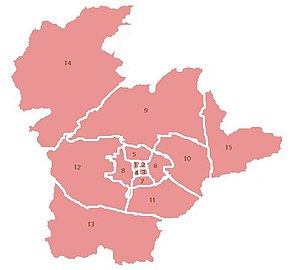Viktringer suburb
| 7. Klagenfurt district of Viktringer Vorstadt |
|
| surface | 70 ha |
| Geographical location | 46 ° 37 ′ N , 14 ° 18 ′ E |
| height | 445 m above sea level A. |
| Residents | 3365 (January 1, 2020) 4807 inhabitants per km² |
| Post Code | 9020 |
| Map of the districts of Klagenfurt | |
|---|---|
The Viktringer Vorstadt is the 7th district of the Carinthian state capital Klagenfurt am Wörthersee ( Austria ).
geography
The Viktringer Vorstadt is located south of the Klagenfurt city center. The district borders in the north on the Viktringer Ring, in the east on the Linienstrasse, in the south the border runs south of the railway line along the Bahnstrasse - Osmanweg - Türkgasse and in the west along the Rosentaler Strasse.
history
The Viktringer Vorstadt belongs to the historical city area of Klagenfurt and includes the area that was south of the former city wall. It was connected to the city center via a city gate. In 1893 the suburb of Viktring was expanded slightly.
Tobacco factory
Many women found a job in the tobacco factory in Klagenfurt, albeit under the worst conditions. They were called Tschickweiber.
There were nine Austrian tobacco factories. The first tobacco factory in Klagenfurt, which existed only for a short time, dates back to 1760. In 1858 the imperial army left the orphanage barracks to the tobacco industry until further notice and a cigar factory was opened on Deutenhofenstrasse. Since the military registered their own needs for the building as early as 1862, they had to look around for a new location and decided to build their own factory on a site made available by the city in today's Bahnhofstrasse between the teacher training institute and the Chamber of Commerce. It started production in 1864 and initially consisted of four objects. In 1871 a building for the production of cut smoking tobacco was built, followed by a machine and boiler house. Another extension took place in 1898. The new raw material magazine was available in 1904, and in 1926 the boiler house was replaced by a high pressure boiler system. The administration building was extended in 1931. Three workers' houses with 76 apartments and a civil servant house with twelve apartments were built for the workforce. In the 1890s an infirmary and a day nursery were established.
At first only cigars were wrapped, but the range was expanded to include cigarettes as early as 1861 and cut smoking tobacco in 1867.
In 1874 the Klagenfurt k. k. Tobacco factory 514 people, in 1890 there were 634. 553 of them were female workers, mostly young women. Girls from seven were accepted. The social conscience left a lot to be desired. The celebration of the 40th anniversary had to be financed by the workforce for a whole year through weekly contributions.
In 1890 the annual production was:
- 757 tons of smoking tobacco
- 99 tons of cigarettes
- 31 tons of cigars
The production was subsequently increased.
In 1900 the staff consisted of 1,009 female and 73 male and female employees. The annual output was:
- 969 tons of smoking tobacco
- 105 million cigarettes (note: changed units)
- 24.5 million cigars
At the time of the monarchy, Hungary , Transylvania and Galicia supplied the raw material . Areas in which the majority of the tobacco factories were located and which no longer belonged to Austria from 1918 onwards.
In 1933 the workforce consisted of 370 workers and 12 salaried employees. 180 machines and motors had taken work away from people.
During the Second World War, airplane parts were manufactured in the tobacco factory. It was then a preferred target for the Allied bombers and was destroyed by bombs. It was not rebuilt after the war. But then a large central tobacco transhipment warehouse was built by the Austria-Tabakwerke in St. Peter-Strasse .
Administrative division
The Viktringer Vorstadt, together with the four districts of Klagenfurt city center and the districts of St. Veiter Vorstadt , Völkermarkter Vorstadt and Villacher Vorstadt, form the cadastral municipality of Klagenfurt.
Buildings
The district belongs to the cathedral parish and does not have its own church. Before 1938, the only Jewish prayer house in Klagenfurt was on Platzgasse.
Sights in the Viktringer Vorstadt include the Koschat Museum, the Musil House and the birthplace of Herbert Böckl.
Economy and Infrastructure
There are many public administration institutions in this district.
- Klagenfurt main station and bus station
- Exhibition grounds and prefabricated house center
- City hall with ice rink of the EC KAC
- State Archives
- State Police Department Carinthia
- former teacher training institute
- Municipal indoor swimming pool
- Chamber of Commerce and Labor, Tax Office, WIFI, Austrian Trade Union Federation, regional health insurance funds, E-Werk, transport companies
Central Station
When the Marburg - Villach-Franzensfeste railway line was implemented, a site in the municipality of St. Ruprecht was chosen for the Klagenfurt train station. The Klagenfurters only extended their Kanalgasse (now Bahnhofstrasse) to the train station.
swell
Footnotes
- ↑ Statistics Austria: Population on January 1st, 2020 by locality (area status on January 1st, 2020) , ( CSV )
- ↑ Anton Kreuzer, “St. Ruprecht - City before the City, Klagenfurts XI. District “, Klagenfurt 2009, Kreuzer-Buch, Einigkeitsstraße 3, 9020 Klagenfurt
literature
- Johann Stermetz: St. Ruprecht and St. Ruperecht Strasse - A local history walk through a district of Klagenfurt. Klagenfurt 2006, publishing house of the Carinthian State Archives







